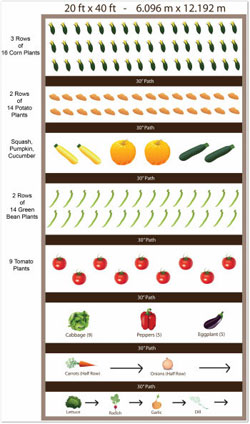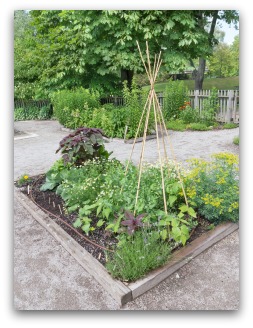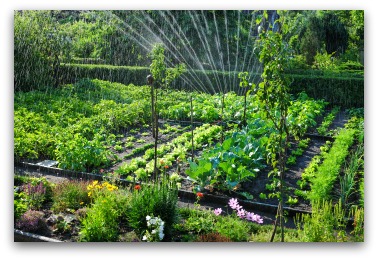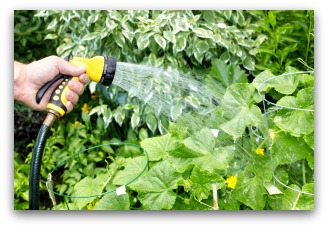Basic Vegetable Garden Design Plans and Tips

Download our basic vegetable garden design and planning worksheets.
Also, we provide free vegetable garden designs and plans to help layout your garden!
Design Your Own Vegetable Garden Layout Using our Free "Vegetable Garden Planner" Software!
Finding a basic garden design that fits your needs is an important first step in planning a garden layout.
If you have a sunny location in your backyard for an in-ground garden, these two types of vegetable garden plans will work for you.
If you don't have room for an in-ground garden, there are many other options available such as a container, four-square, or raised bed vegetable garden.
Whatever type you choose, growing your own produce can be a great adventure and learning experience!
Download Free Garden Planning Worksheets, Garden Diary, Zone Chart, Or Planting Guide
Traditional In-Ground Row Garden Layout
The traditional basic vegetable garden design has been straight and long rows running from north to south.
- Usually
anything growing tall, like corn, beans or peas are planted on the
north side of the vegetable garden to keep them from casting shade on
the shorter crops.
- Medium growing vegetables like
tomatoes, cabbage, broccoli, squash and pumpkins are planted in the
center, while the southern end of the garden contains the shorter
plants, like carrots, beets, lettuce, radishes and onions.
- In general, a vegetable garden design runs from south to north, to make the most of sun exposure and air circulation.
- This
very basic vegetable garden design is meant to make cultivation easier,
as well as for convenience when weeding and harvesting.
With smaller yards and urban gardens becoming common, the traditional basic vegetable garden design is no longer suitable in some situations.
This article will focus on showing you basic and easy methods of creating your own vegetable garden design.
Square Foot Garden Design
Click Here for a Free Square-Foot Garden Plan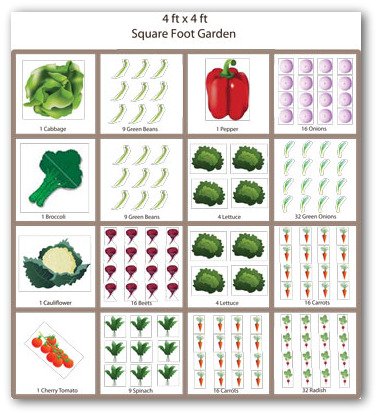
This very simple and easy first garden design is called the square foot garden.
This gardening style was developed by Mel Bartholomew.
Click to download plan and planting instructions.
Basic 4 Square Rotation Basic Vegetable Garden Design
Take out a pen and paper and draw a square. Divide the square into four by drawing a cross inside it.
You now have a diagram of four square beds that you’ll use as a plan for your very own vegetable garden design.
The four beds are for the four main groups of vegetable crops.
The plants are divided into four categories based on the amount of nutrients that they need to flourish.
Below is an example of these categories.
- Heavy feeders: These heavy feeders demand a lot of nitrogen. Examples of these are the large leafed plants like lettuce, corn, and even the vine crops like squash.
- Middle Feeders: These middle-of-the-road feeders are the mid sized leafed plants with above-ground fruits like tomatoes and peppers.
- Light Feeders: These feeders include the root crops like turnips and carrots. They like potash in the soil.
- Soil Builders: These types leave more nitrogen in the soil than they take out. Examples of these are the legumes like peas and beans.
How to Rotate Your
Four Square Garden
Now it’s time to explain the rotation for this most basic of vegetable garden designs!
- Each of the four types mentioned above goes into one of squares that you’ve diagrammed, called beds.
- From top-left and counter-clockwise; Heavy Feeders, Middle Feeders, Light Feeders and the Soil Builders.
- After every harvest and when replanting each season, you rotate each
group to the next square, to reduce pests and soil problems.
- Make sure that when you rotate these four types, they always follow the same order given here.
- This means, that when you move the Heavy Feeders, they go to the Soil Builder’s previous position.
- The Middle Feeders move up to the Heavy Feeders' former position, etc.
Try to imagine a baseball game where in your players occupy bases.
Each year you move the location of each plant group by one space, changing the location of your plant types.
Another benefit of this kind of rotation is that the Heavy Feeders will grow better by transferring to the Soil Builder’s former spot which gives them more of the nutrients they require to flourish.
Conditioning and Preparing Your Garden Soil
Your garden will grow best in enriched well-conditioned soil.
If you don't know your soil composition, it is best to find out by taking a sample to your local garden center.
Then you can add compost, sand, humus, fertilizer and any other ingredients as needed to create the best environment for your plants.
In order for your garden to thrive, the soil should also be well-drained.
Watering Your Vegetable Garden
When planning your basic vegetable garden design, be sure to locate your garden near a convenient source of water.
Especially when the plants are small, they will need to be watered frequently as the root systems are small and will dry out quickly.
After your plants are well-established, less-frequent deep watering is best!Plant your garden away from tree and shrub roots that can take moisture away from your plants.
It’s important to know that there are many variations of vegetable garden designs.
These are two of the most basic and easiest garden plans.
You can certainly use what you’ve learned here and design your own garden by basing it on one of these easy methods.
Whether you are a beginner or an experienced gardener, finding the right design for your vegetable garden is part of the adventure.
So experiment, and have some fun!
